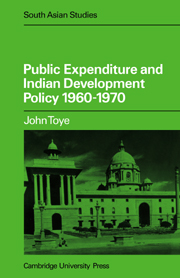Book contents
- Frontmatter
- Contents
- List of Tables
- Preface
- List of Abbreviations
- Introduction
- PART ONE GENERAL
- PART TWO EMPIRICAL EVIDENCE
- 4 The fiscal performance of the public sector
- 5 Public expenditure and the industrial recession
- 6 The degree of public expenditure centralization
- 7 The growth of state governments' spending
- 8 Public investment, public saving and the state governments
- PART THREE CONCLUSIONS
- APPENDICES
- List of works cited
- Index
7 - The growth of state governments' spending
from PART TWO - EMPIRICAL EVIDENCE
Published online by Cambridge University Press: 09 January 2010
- Frontmatter
- Contents
- List of Tables
- Preface
- List of Abbreviations
- Introduction
- PART ONE GENERAL
- PART TWO EMPIRICAL EVIDENCE
- 4 The fiscal performance of the public sector
- 5 Public expenditure and the industrial recession
- 6 The degree of public expenditure centralization
- 7 The growth of state governments' spending
- 8 Public investment, public saving and the state governments
- PART THREE CONCLUSIONS
- APPENDICES
- List of works cited
- Index
Summary
INTER-STATE DIFFERENCES IN PUBLIC EXPENDITURE GROWTH
When the states are considered as a group, which is then contrasted with the centre, they have a broad similarity defined by their relationship to the centre. Each state is taken as having a geographically limited sub-jurisdiction, as receiving some central financial assistance, and as being charged with certain constitutional expenditure responsibilities and taxation powers. This is perfectly correct as far as it goes. But it obviously does not give a complete picture. State governments in a federation combine juridical similarity with pronounced economic and political dissimilarity.
India is a federation by disaggregation. Its federal scheme emerged by a process of devolution of central government powers on states (provinces), which was linked with the transition from a colonial to a post-colonial regime. Under the British, it is clear that a strong element of political calculation in the face of nationalist pressure prompted the twin moves towards quasi-democracy and federalism. But why, at independence, the federal provisions of British legislation were adopted so swiftly and with so little contest is not at all clear from the history of constitution-making. There seems simply to have been general agreement that the size and diversity of India, and the fragmented nature of its civil polity, would have been incompatible with a unitary regime.In other words, economic and political dissimilarities between the units of the federation were the causes of the adoption of the federal form of government, given the prior decision in favour of a formal parliamentary democracy.
- Type
- Chapter
- Information
- Public Expenditure and Indian Development Policy 1960–70 , pp. 158 - 175Publisher: Cambridge University PressPrint publication year: 1981



